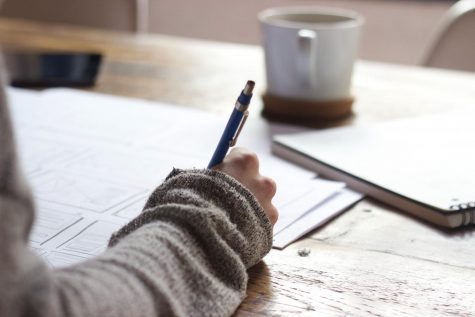Curious about A&P I? Here are some things to know
Hello, my lovely readers! Did you survive finals? Are you enjoying a well deserved respite from the hectic environment of school? Though it was a rough one according to many, the fall 2019 semester has finally come to an end, and Christmas is quickly approaching. What better way to spend the break than to give you insight into Anatomy and Physiology I? Consider it a present from me to you.
Now, keep in mind that I took Dr. Daniel Holt for A&P I, so my experiences with him likely will not be a mirror image of students’ experiences with other professors. However, you can still take away key tips for the course overall even if your professor is not Dr. Holt.
Overall, with this class, you need to study consistently–practically every day. You will cover a wide range of topics: major themes of the field, basic chemistry, cells and their organelles, tissues, the integumentary system (AKA, your skin), bone tissue and formation, joints, muscles and muscle tissue (including the process of muscle contraction), nervous tissue (with action potentials!), the central nervous system, the peripheral nervous system and associated reflexes (the plexuses are the biggest pains here), the autonomic nervous system, and sense organs. If that seems like a lot, it is. However, as long as you study each day (or at least once every two days), the information will be reduced to tolerable chunks. This goes for the lab as well, which will cover extra information on top of what you are learning in lecture, including memorizing and understanding microscope slides (for tissues and cells) and the muscles and other structures on models. The biggest tip I can offer with lab is to take good, clear pictures (and to check them with the professor to ensure you’re looking at the right thing–it’s very easy to make an error here!). Additionally, if you cannot find the time to take pictures during lab or simply feel that studying the lab manual/papers isn’t enough (which is often the case), take time out of at least one day each week to review slides, models, and other materials offered in the lab. I chose to go on Saturdays and Sundays since most students are not on campus these days, especially early in the morning (between eight AM and ten AM, though late evenings work too). However, on these days, you will need to remember to take your lab pass with you and a phone to contact the police with since the labs will be locked. (Also, be sure to lock the lab doors if you are the last to leave; otherwise, you and all other students may lose access to the lab entirely!) Additionally, the lab will be closed on certain days, such as Thursdays and days before exams, so you will need to consider this with your study routine.
For my class, we had three lecture exams, daily iClicker quizzes (which can give you up to 20 extra points on an exam), a final lecture exam, almost biweekly lab quizzes, a lab midterm exam, and a lab final exam. Sometimes, the information in lecture and (especially) lab was breezed through due to the depth of information and shortage of time. On these days, you’ll have to put in extra work reviewing your notes after class/lab as well as accessing other sources for help, like YouTube and Google searches. Because Dr. Holt essentially condensed the textbook chapters into PowerPoint lectures, we did not need the textbook for the class. In fact, I only used it once or twice to read parts that I didn’t understand as well, including for membrane proteins, local potentials, and action potentials. However, while I think it’s still a good idea to purchase the book for helping you better understand more complicated or dense topics, as long as you study well and use trustworthy Internet sources, I wouldn’t say that you absolutely need it to pass or even make an A in the course. (But again, this is for Holt only and based off of my experience alone.) The lab manual on the other hand is something that you absolutely cannot go without and contains all necessary lab information for both A&P I and II.
So, how should you study? Personally, I would format questions based off of the lecture notes and write them down on flash cards. I would then practice by reading the questions aloud (or having a friend do this for me) and seeing if I could answer each question correctly. If I missed a question entirely or even just felt unsure about my understanding, I would mark the question with a red pen. The next time, I would go only through the marked questions and would mark them in a different colored pen if I missed them again. (However, before any exam, I would go through all of the questions again, regardless of previous markings.) Did this take hours? Yes. But did it work? Absolutely. I also would simply read through the lecture notes for further review and occasionally made mnemonics and silly word associations for parts that required rote memorization. But above all else, practice and repetition are truly key here, and I wasn’t kidding when I stressed studying almost every single day. (With lecture and lab material combined, you’ll really have to if you want to pass, and even more so if you want an A in the class.) Additionally, some people attempt to form and use study groups in A&P. These typically fail to help anyone since people are drawn to socialize, and I don’t recommend them at all. However, practicing with a friend or two as final review is helpful–but only if you both studied beforehand!
As for lab, I suggest reading through the entire lab exercise sections in the manual but only making study materials for what your professor specifies. With Holt, everything you would be tested on was listed on a sheet of paper (per lab), so I used that as a sort of guide with reading through the lab manual and organizing my study materials. Also, take notes to summarize main points of the lab manual, and take notes for any lab lectures! And for any sections that require memorization of structures/images, including the body landmark terms, tissues, muscles, brain, ear, and eye, you should use something to cover up the answers as you study. (I would cut up sticky notes into strips and arrange them so that they stuck to the page and covered each term I needed to study. This allowed for hiding of the answers until I needed to check myself.) On top of using your lab manual, as I pointed out before, using the microscope slides and models in lab is truly crucial to performing well on the quizzes and exams. You should go for a few hours at least once a week to look at and quiz yourself on the materials. (And take pictures so that you can continue to study at home! I now have several picture albums in my phone devoted to A&P labs.) Also, remember that your professor is an excellent resource if you’re stuck or need extra help. Dr. Holt especially would allow you to visit him during his office hours to quiz you over lab and/or lecture materials, and he would even stay after class to answer questions.
Hopefully, this will aid you in your journey through A&P I. However, I have some final tips and reminders to close off with. Firstly, since you are doing a lot of studying, it helps to make the process more fun by including a friend who’s willing to quiz you, using background music to pump you up, and changing your study environment (I especially loved studying downtown, though it sometimes got too loud for my taste). Also, keep in mind that this information is integral to your profession in the medical field, so even if you do not enjoy the structure of the class or the teaching style and personality of the professor, take the time to appreciate the dynamics of the body and the exploration of something that will be applicable to your career and life in general. If you can find that intrinsic motivation–that delight in learning–and put forth consistent effort, success should follow. But if you find the information dreadful and boring (regardless of the professor), you may want to reconsider your career choice. And if possible, choose a professor who teaches the class well and is open to helping his/her students. (Would I recommend Holt? A hard and solid yes.) And of course, as usual, what works for me may not work as well for you, so if you don’t find that using flashcards helps, experiment and find a way that suits you! However, if you’re unsure, flashcards and asking/answering questions out loud are fairly reliable choices for most people.
If you’re interested to know the books used in this class, the textbook was Anatomy and Physiology: The Unity of Form and Function, 8th edition by Kenneth S. Saladin, and the lab manual was Human Anatomy and Physiology: Lab Manual, third custom edition for Columbus State University. But as you noticed, I used the past tense with these, so while they may work for preparing for the class ahead of time, they may not be the ones needed for future classes as time goes on.
Nursing students unite!





